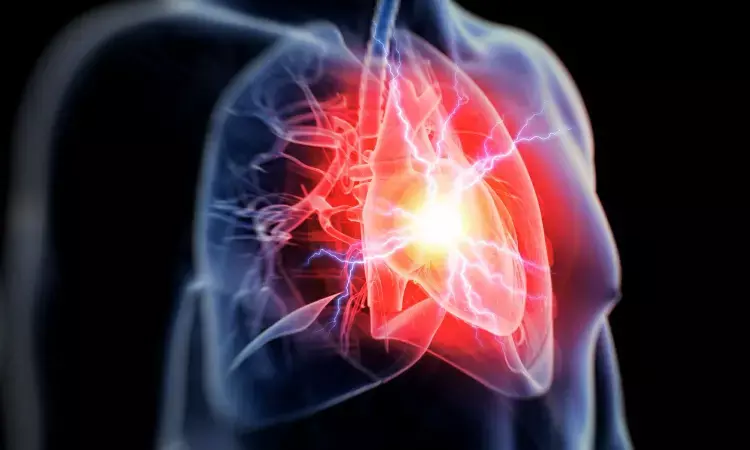- Home
- Medical news & Guidelines
- Anesthesiology
- Cardiology and CTVS
- Critical Care
- Dentistry
- Dermatology
- Diabetes and Endocrinology
- ENT
- Gastroenterology
- Medicine
- Nephrology
- Neurology
- Obstretics-Gynaecology
- Oncology
- Ophthalmology
- Orthopaedics
- Pediatrics-Neonatology
- Psychiatry
- Pulmonology
- Radiology
- Surgery
- Urology
- Laboratory Medicine
- Diet
- Nursing
- Paramedical
- Physiotherapy
- Health news
- Fact Check
- Bone Health Fact Check
- Brain Health Fact Check
- Cancer Related Fact Check
- Child Care Fact Check
- Dental and oral health fact check
- Diabetes and metabolic health fact check
- Diet and Nutrition Fact Check
- Eye and ENT Care Fact Check
- Fitness fact check
- Gut health fact check
- Heart health fact check
- Kidney health fact check
- Medical education fact check
- Men's health fact check
- Respiratory fact check
- Skin and hair care fact check
- Vaccine and Immunization fact check
- Women's health fact check
- AYUSH
- State News
- Andaman and Nicobar Islands
- Andhra Pradesh
- Arunachal Pradesh
- Assam
- Bihar
- Chandigarh
- Chattisgarh
- Dadra and Nagar Haveli
- Daman and Diu
- Delhi
- Goa
- Gujarat
- Haryana
- Himachal Pradesh
- Jammu & Kashmir
- Jharkhand
- Karnataka
- Kerala
- Ladakh
- Lakshadweep
- Madhya Pradesh
- Maharashtra
- Manipur
- Meghalaya
- Mizoram
- Nagaland
- Odisha
- Puducherry
- Punjab
- Rajasthan
- Sikkim
- Tamil Nadu
- Telangana
- Tripura
- Uttar Pradesh
- Uttrakhand
- West Bengal
- Medical Education
- Industry
Greater Splanchnic Nerve Ablation Shows Feasibility but No Clinical Benefit in HFpEF Patients: REBALANCE-HF Trial

USA: A recent study has emerged from the REBALANCE-HF randomized clinical trial, exploring the efficacy of endovascular ablation of the greater splanchnic nerve (ESN) in patients suffering from heart failure with preserved ejection fraction (HFpEF).
The study, published in JAMA Cardiology, revealed that endovascular right-sided splanchnic nerve ablation for volume management (SAVM) demonstrated safety and technical feasibility; however, it failed to lower exercise pulmonary capillary wedge pressure (PCWP) at one month and did not lead to improvements in clinical outcomes after 12 months among a diverse group of patients with HFpEF.
Heart failure with preserved ejection fraction affects a significant number of patients, presenting unique challenges in management due to the lack of effective treatment options. Ablation of the greater splanchnic nerve could potentially enhance hemodynamics in these patients. Considering this, Marat Fudim, Duke University Medical Center Durham, North Carolina, and colleagues investigated the safety and feasibility of endovascular right-sided splanchnic nerve ablation for volume management.
For this purpose, the researchers conducted a phase 2, double-blind, randomized clinical trial across 14 centers in the US and one in Georgia. The study included patients with HFpEF with a left ventricular ejection fraction of 40% or higher and a peak exercise pulmonary capillary wedge pressure (PCWP) of 25 mm Hg or more. Data analysis was from May 2023 to June 2024.
Participants underwent either the SAVM procedure or a sham control procedure. The main goal was to see if SAVM could reduce leg-up and exercise PCWP at one month. Additionally, the study aimed to assess serious adverse events related to the device or procedure during the same period. Secondary goals included tracking hospitalizations for heart failure, changes in exercise function and health status over 12 months, and changes in resting, legs-up, and 20-W exercise PCWP from baseline to one month.
The following were the key findings of the study:
- Ninety patients participated in the study, with a median age of 71, and 64.4% were female. Patients were randomized at 15 centers, with 44 receiving the SAVM procedure and 46 undergoing a sham.
- The results showed no significant differences in adverse events between the two groups.
- The primary goal of reducing PCWP did not show any improvement with SAVM compared to sham, with a mean difference of −0.03 mm Hg. Additionally, there were no notable differences in the secondary outcomes.
- Regarding safety, the rate of serious adverse events was similar between the treatment group (6.8%) and the sham group (2.2%), resulting in a difference of 4.6%.
- The incidence of orthostatic hypotension was also comparable, with 11.4% in the treatment group and 6.5% in the sham group.
"The results indicate that SAVM did not lower exercise pulmonary capillary wedge pressure or improve clinical outcomes in a diverse group of patients with heart failure and preserved ejection fraction," the researchers concluded.
Reference:
Fudim M, Borlaug BA, Mohan RC, et al. Endovascular Ablation of the Greater Splanchnic Nerve in Heart Failure With Preserved Ejection Fraction: The REBALANCE-HF Randomized Clinical Trial. JAMA Cardiol. Published online October 02, 2024. doi:10.1001/jamacardio.2024.2612
Dr Prem Aggarwal, (MD Medicine, DNB Medicine, DNB Cardiology) is a Cardiologist by profession and also the Co-founder and Chairman of Medical Dialogues. He focuses on news and perspectives about cardiology, and medicine related developments at Medical Dialogues. He can be reached out at drprem@medicaldialogues.in


